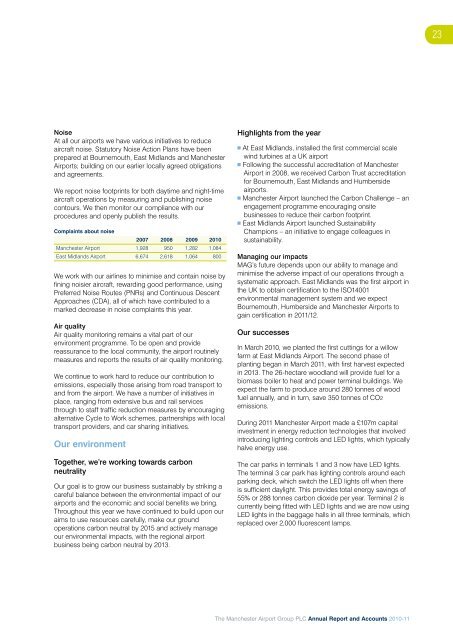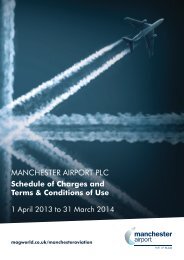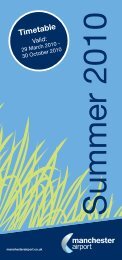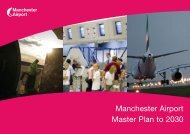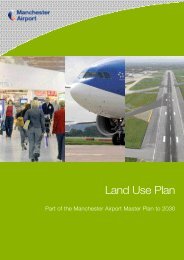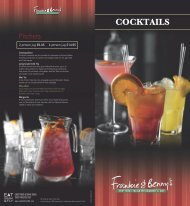Annual Report and Accounts 2010-11 - Manchester Airport
Annual Report and Accounts 2010-11 - Manchester Airport
Annual Report and Accounts 2010-11 - Manchester Airport
- No tags were found...
You also want an ePaper? Increase the reach of your titles
YUMPU automatically turns print PDFs into web optimized ePapers that Google loves.
23NoiseAt all our airports we have various initiatives to reduceaircraft noise. Statutory Noise Action Plans have beenprepared at Bournemouth, East Midl<strong>and</strong>s <strong>and</strong> <strong>Manchester</strong><strong>Airport</strong>s; building on our earlier locally agreed obligations<strong>and</strong> agreements.We report noise footprints for both daytime <strong>and</strong> night-timeaircraft operations by measuring <strong>and</strong> publishing noisecontours. We then monitor our compliance with ourprocedures <strong>and</strong> openly publish the results.Complaints about noise2007 2008 2009 <strong>2010</strong><strong>Manchester</strong> <strong>Airport</strong> 1,928 950 1,282 1,084East Midl<strong>and</strong>s <strong>Airport</strong> 6,674 2,618 1,064 800We work with our airlines to minimise <strong>and</strong> contain noise byfining noisier aircraft, rewarding good performance, usingPreferred Noise Routes (PNRs) <strong>and</strong> Continuous DescentApproaches (CDA), all of which have contributed to amarked decrease in noise complaints this year.Air qualityAir quality monitoring remains a vital part of ourenvironment programme. To be open <strong>and</strong> providereassurance to the local community, the airport routinelymeasures <strong>and</strong> reports the results of air quality monitoring.We continue to work hard to reduce our contribution toemissions, especially those arising from road transport to<strong>and</strong> from the airport. We have a number of initiatives inplace, ranging from extensive bus <strong>and</strong> rail servicesthrough to staff traffic reduction measures by encouragingalternative Cycle to Work schemes, partnerships with localtransport providers, <strong>and</strong> car sharing initiatives.Our environmentTogether, we’re working towards carbonneutralityOur goal is to grow our business sustainably by striking acareful balance between the environmental impact of ourairports <strong>and</strong> the economic <strong>and</strong> social benefits we bring.Throughout this year we have continued to build upon ouraims to use resources carefully, make our groundoperations carbon neutral by 2015 <strong>and</strong> actively manageour environmental impacts, with the regional airportbusiness being carbon neutral by 2013.Highlights from the yearn At East Midl<strong>and</strong>s, installed the first commercial scalewind turbines at a UK airportn Following the successful accreditation of <strong>Manchester</strong><strong>Airport</strong> in 2008, we received Carbon Trust accreditationfor Bournemouth, East Midl<strong>and</strong>s <strong>and</strong> Humbersideairports.n <strong>Manchester</strong> <strong>Airport</strong> launched the Carbon Challenge – anengagement programme encouraging onsitebusinesses to reduce their carbon footprint.n East Midl<strong>and</strong>s <strong>Airport</strong> launched SustainabilityChampions – an initiative to engage colleagues insustainability.Managing our impactsMAG’s future depends upon our ability to manage <strong>and</strong>minimise the adverse impact of our operations through asystematic approach. East Midl<strong>and</strong>s was the first airport inthe UK to obtain certification to the ISO14001environmental management system <strong>and</strong> we expectBournemouth, Humberside <strong>and</strong> <strong>Manchester</strong> <strong>Airport</strong>s togain certification in 20<strong>11</strong>/12.Our successesIn March <strong>2010</strong>, we planted the first cuttings for a willowfarm at East Midl<strong>and</strong>s <strong>Airport</strong>. The second phase ofplanting began in March 20<strong>11</strong>, with first harvest expectedin 2013. The 26-hectare woodl<strong>and</strong> will provide fuel for abiomass boiler to heat <strong>and</strong> power terminal buildings. Weexpect the farm to produce around 280 tonnes of woodfuel annually, <strong>and</strong> in turn, save 350 tonnes of CO2emissions.During 20<strong>11</strong> <strong>Manchester</strong> <strong>Airport</strong> made a £107m capitalinvestment in energy reduction technologies that involvedintroducing lighting controls <strong>and</strong> LED lights, which typicallyhalve energy use.The car parks in terminals 1 <strong>and</strong> 3 now have LED lights.The terminal 3 car park has lighting controls around eachparking deck, which switch the LED lights off when thereis sufficient daylight. This provides total energy savings of55% or 288 tonnes carbon dioxide per year. Terminal 2 iscurrently being fitted with LED lights <strong>and</strong> we are now usingLED lights in the baggage halls in all three terminals, whichreplaced over 2,000 fluorescent lamps.The <strong>Manchester</strong> <strong>Airport</strong> Group PLC <strong>Annual</strong> <strong>Report</strong> <strong>and</strong> <strong>Accounts</strong> <strong>2010</strong>-<strong>11</strong>


